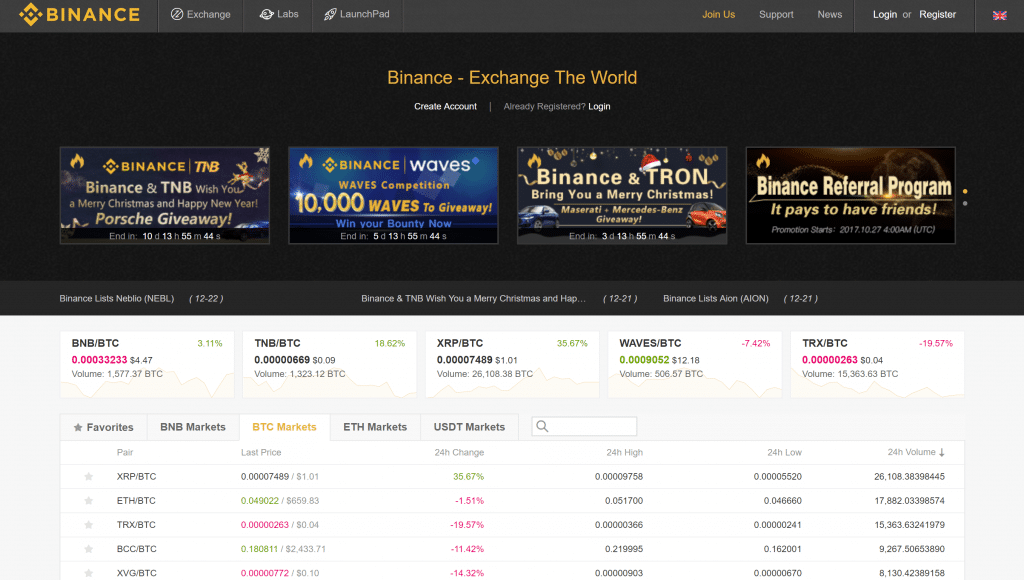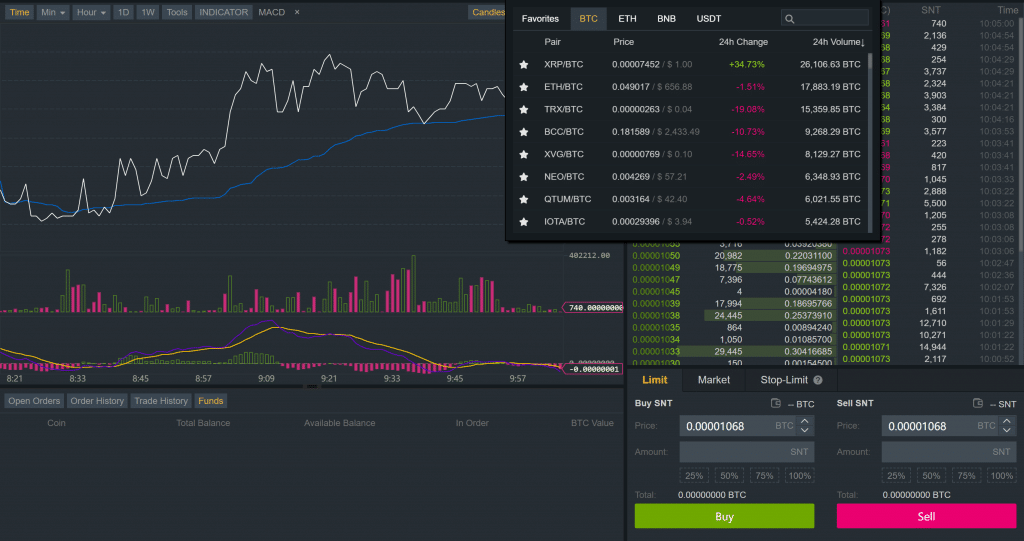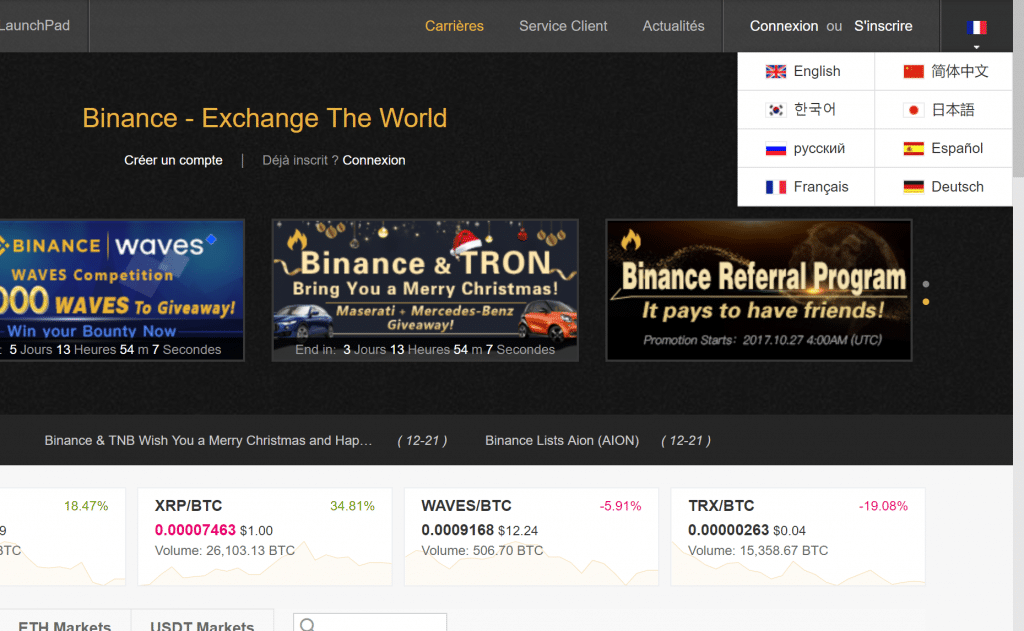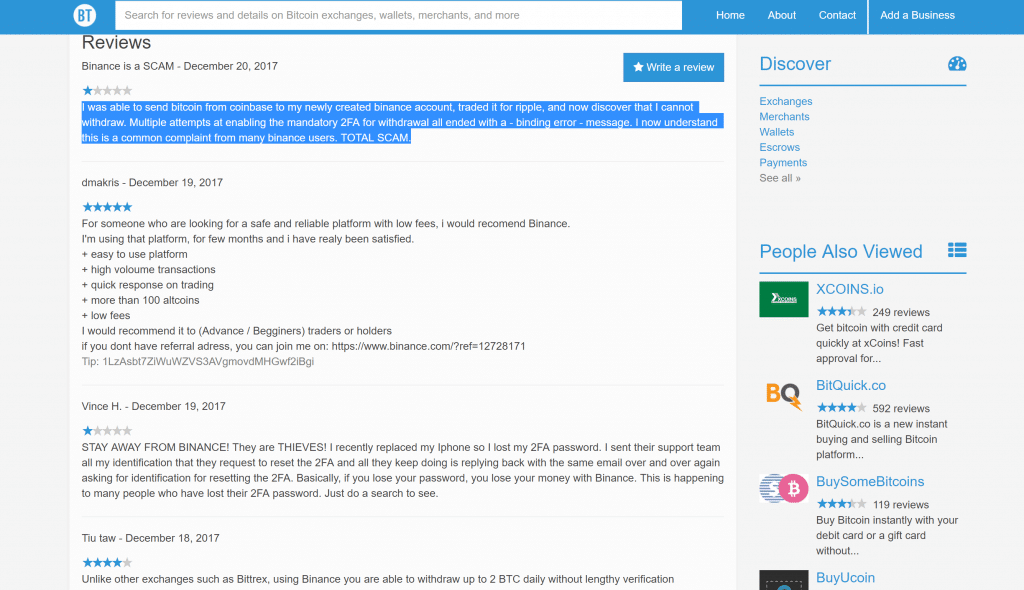Binance Review: Is It a Legit Cryptocurrency Exchange?
Binance
is a Hong Kong–based cryptocurrency exchange launched by developer
Changpeng Zhao in July 2017. Zhao’s company Beijie Technology created
the exchange after a successful ICO that raised $15 million.
Beijie Technology and its founder maintain an impressive track record within the industry. Zhao’s CV
includes high-profile positions, such as technical director at
Blockchain.info, and his company now provides trading systems for over
30 other platforms.
Following struggles with the Chinese government’s views on
cryptocurrencies, Binance now runs its servers from more lenient states,
providing it with the freedom to run a competitive exchange service.
“In response to China’s decisions, we are moving our IP’s
from Hong Kong to an offshore location. So we are registered in multiple
locations and we have people in multiple locations. That way we will
never be affected by one regulatory body,” explained Zhao.
The trading exchange has been experiencing astounding
success since its summer launch, and it now even sits around the top ten
in terms of 24-hour trading volumes on Coinmarketcap.

So why is Binance becoming so popular, and is it useful for your cryptocurrency trades?
Currency support
Binance
offers a crypto-to-crypto exchange, meaning that it doesn’t facilitate
any fiat currencies. This allows the platform to work freely, steering
clear of any red tape or regulation (for now).
There’s an impressive cryptocurrency selection on offer in conjunction with the Bitcoin, Ether, Bread, and Tether trading pairs. All in all, the number of coins available is nearly 100, and all major altcoins, including Litecoin, Ripple, and Bitcoin Cash, are in the listing. Adding to this is a neat roster of up-and-coming altcoins.

Fees
In a competitive space, the fee structure on Binance is cutting edge.
Its team members have sharpened their knives and are slicing the
opposition apart.
A flat rate of 0.1%
is very enticing for any trader who doesn’t need immediate fiat
liquidation. Incredibly, it undercuts most other large exchanges, some
of which charge upward of 0.2%. That’s a pretty sizeable difference if
you’re working with large orders.
For the time being, BNB, the native Binance token, even provides a 50% discount on this trade fee when working with the coin.
Deposits are free, as you’d expect (it’s generally the sending wallet
that pays blockchain fees with cryptocurrencies). Withdrawal fees do
apply, although they generally correlate with the blockchain transaction
fees. The withdrawal fee seems to be updated on a regular basis to try
and offer a fair price.
At the time of writing, a Bitcoin withdrawal costs around $8, while a
Litecoin withdrawal is around $0.33. It’s a sign of the times for
Bitcoin. It’s a good idea not to move Bitcoin around if possible, as it
will eat into your profits; try to use faster and cheaper options such
as Litecoin if you can.
Customer support
Binance does an adequate job in terms of its customer support. Most
inquiries need to be made via the site’s email contact form, and after
that, it’s simply a matter of waiting. As with most major trading
exchanges, you may have to wait awhile for a response simply due to the
sheer growth in demand.
There is a Wechat customer service QR code to tap into that may help
via a quick live chat, but some of the responses are automated (and in
Chinese). On testing the Wechat, I originally received an automatic
reply pointing me to support page links. Five minutes later, another
notification revealed what seemed to be an actual person on the other
end. My Chinese wasn’t good enough to decipher the messages without
Google Translate, but it all seems legitimate.
Happily, the website is completely multilingual, so most people
should get along fine in one language or another. English, French,
Spanish, German, Korean, Japanese, and Chinese are all options on the
exchange. This is another real advantage for Binance as it seeks to
compete as a global cryptocurrency exchange.

Public opinion/online reviews
There’s a lot to love about Binance, and many traders continue to be
upbeat about the service. Low fees, a responsive exchange, and
developers with a proven track record leave most people beaming. Binance
has generally been considered a comprehensive success in its short life
so far.
One thing to keep in mind is that Binance offers an affiliate
program, which gets a lot of people to speak highly of it while trying
to push their affiliate links to earn some extra cash. Take every
positive review you read with a grain of salt if it’s accompanied by an
affiliate link.
One major problem does appear to be a thorn in the site’s side: Many reviews
complain about a faulty 2FA/SMS confirmation. The temperamental nature
of this setup for Binance means that a few customers struggle to
withdraw funds. In fact, it’s such a problem that scam allegations have
been pointed at the service.

To be honest, dodgier prospects exist across the industry,
and I see this as more of a technical issue than a scam. It’s probable
that this hiccup will be ironed out in 2018, after which I expect the
Binance exchange to drive to an even higher market cap.
Conclusion: Is Binance a good exchange?
When we pull everything together and look at Binance objectively, the
pros far outweigh the cons. This is more than can be said for some
other competitors. The exchange’s low fees combined with the team’s
proven knowledge of how to build a trading platform is enough to make it
a major player.
It’s no wonder that success followed the service during its
opening months. Add to this the ability to offer a truly worldwide
service away from the grip of the Chinese government, and there’s not
much to stop Beiji Technology.







0 Response to "Binance Review: Is It a Legit Cryptocurrency Exchange?"